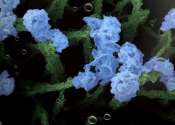Bacteria adapt syringe apparatus to changing conditions
Some of the best-known human pathogens—from the plague bacterium Yersinia pestis to the diarrhea pathogen Salmonella—use a tiny hypodermic needle to inject disease-causing proteins into their host's cells, thereby manipulating ...









